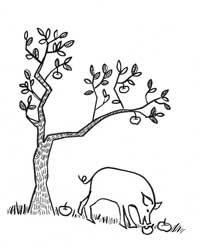 |
| Toki Oshima drawing |
By C.J. Walke
Organic growers face numerous challenges with pest management, regardless of the crops grown, and look to crop rotation, biological controls and carefully timed applications of approved materials to target the pest at hand. Organic tree fruit are vulnerable to many insect pests over the course of the season, whether those pests emerge at bloom or midsummer and whether one or multiple generations look to feed on developing fruit.
The Research
Managing dropped fruit is an effective cultural method of impacting orchard insect populations, since drops often contain pest larvae, but it is also time-consuming for the grower. However, research in recent years is showing that flash grazing pigs in the orchard can help interrupt insect life cycles and add other benefits to the orchard ecosystem. Flash grazing uses a high concentration of livestock to graze a paddock over a short period of time.
Most of this research has been conducted by Michigan State University faculty and graduate students at organic apple, pear and cherry orchards in Michigan. They have focused on disrupting the life cycle of plum curculio in the orchard by flash grazing pigs during the “June drop” period.
Curculio adults emerge before apple bloom to mate and lay eggs on or near developing fruitlets. By late June, affected fruitlets start to drop from the tree, often containing curculio larvae or other internal fruit feeding pests. This is referred to as “June drop.”
The life cycle of plum curculio depends on the infected fruit dropping to the ground so that the larva can exit the fruit, burrow into the soil, pupate and emerge later in the summer as an adult. In the Northeast, this new generation is not believed to breed in late summer but continues to feed on developing fruit, leaving feeding stings and scars. It then overwinters in leaf litter and ground debris to emerge the following spring and continue the cycle.
The studies focused on rotating groups of hogs through the orchard over the course of two to three weeks during “June drop” so that they could feed on drops and root in the soil. The numbers of hogs used in the studies varied, but roughly two dozen pigs grazed a 1-acre paddock for three to five days. The pigs consumed 99.8 percent of all drops. At harvest, ungrazed sections of the orchard had three to five times greater plum curculio damage on fruit than grazed sections. Researchers also examined fecal samples and confirmed that curculio larvae could not survive the pigs’ digestion process.
The Practice
The primary concern with integrating livestock and crops in certified organic systems is that organic growers must observe the manure waiting period of either 90 or 120 days, depending on whether the crop contacts the soil. For tree fruit, 90 days must pass between the last application of manure and the first harvest of fruit, since the fruit is not in direct contact with the soil.
The challenge is that this 90-day period from “June drop” means that summer apples (Red Astrachan, Gravenstein, William’s Pride) cannot be part of this system, but winter apples with a later harvest (Golden Russet, Northern Spy, Black Oxford) will fit. Fall apples will vary depending on harvest date. To set some dates, if you remove pigs from the orchard by July 2, you will have 90 days to harvest on October 1. (Please confirm this with your certifying agency before setting plans.)
Smaller, diversified orchards may have trouble implementing such a plan because varieties may be inter-mixed and buffers would need to be established and maintained. (This is another question for your certifier.) However, in orchards with larger, single variety blocks, growers will have an easier time establishing paddocks and maintaining buffers.
Another benefit to flash grazing pigs in the orchard is that it may manage pests other than plum curculio. Plum curculio was the focus of the Michigan research and one of the most difficult pests to control in organic orchards. European apple sawfly larvae and first generation codling moth larvae are also common in “June drop” apples, so some control of those pests will coincide with plum curculio activity.
If pigs are grazed post-harvest, later in the fall, then the manure waiting period is not an issue and orchardists will reap additional benefits. Drops and culls will still exist for the pigs to clean up, and late fall grazing will also offer disease management benefits, especially with apple scab, since the scab fungus overwinters on infected leaves and fruit on the orchard floor.
Even though the manure waiting period is not an issue in the fall, flash grazing (rather than longer-term grazing) should still be used to minimize manure buildup beneath the trees so that excess nitrogen, which could interrupt the hardening off process and winter dormancy of the trees, is not a problem. And throughout the system, moving the pigs frequently limits pigs’ rooting and avoids damage to tree roots.
Flash grazing pigs at these specific times can have solid benefits toward managing insect and disease pressures in the organic orchard. Some of the research also focused on feeder pig growth and calculated nutritional benefits when incorporating flash grazing into the hogs’ diet. This research shows that the process benefits both the orchard fruit and the feeder pigs. For more information, follow the links below or search for “flash grazing pigs MSU.”
https://cerestrust.org/potential-of-organic-hogs/
https://www.opm.msu.edu/wp-content/uploads/2011/03/BringingHometheBacon_KristaBuehrer.pdf
C.J. Walke is MOFGA’s organic orchardist. You can contact him at [email protected].

